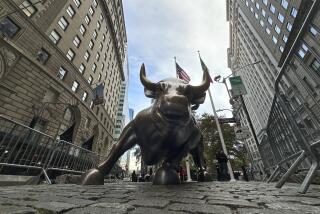Oil Futures Set Record; Gas Soars
- Share via
Oil prices hit a record high Monday and gasoline futures surged as the death of Saudi Arabia’s King Fahd added to traders’ fears of potential disruptions in global energy supplies.
Prices of diesel fuel, heating oil and natural gas also rose, propelled by oil’s climbing cost and a series of U.S. refinery problems.
The rally could signal higher pump prices in coming days, as well as strains on utilities that own natural gas-fired power plants. It also keeps pressure on the airline industry, which has been battered by high jet-fuel prices and has raised fares to help make up the difference.
The U.S. benchmark crude for September delivery jumped as high as $62.30 a barrel before closing at $61.57, up $1, on the New York Mercantile Exchange, the highest closing price since the exchange began trading oil futures contracts in 1983.
The previous record close was $61.28 a barrel set July 6, and the previous intra-day peak of $62.10 came a day later.
However, prices remain below their all-time highs when inflation is taken into account. After the 1979 Iranian revolution, oil prices traded between $80 and $90 a barrel in today’s dollars.
In other Nymex trading, gasoline futures for September delivery rose 2.10 cents to $1.747 a gallon, and heating oil climbed 4.07 cents to $1.717 a gallon. Natural gas futures rose 26.9 cents to $8.154 per 1,000 cubic feet.
The potential for increased tensions in the Middle East was very much on traders’ minds Monday, and not just because of Fahd’s death. The market also was jittery over Iran’s threat to restart some of its nuclear-power activities, a move that could heighten tensions between the U.S. and Iran, the Organization of the Petroleum Exporting Countries’ second-largest oil producer behind Saudi Arabia.
Worldwide supplies of oil and gasoline are currently sufficient to meet demand, analysts generally agree. But prices have soared over the last year because that demand keeps growing -- especially in the United States and China -- and producers such as Saudi Arabia already are pumping near their capacity.
With such a skimpy cushion, traders constantly fret that any disruption to that production could cause shortages. Prices have repeatedly spiked on news of poor weather, terrorism and political upheaval in oil-producing countries.
“Any little thing can make prices shoot higher these days,” said David Hackett, president of Stillwater Associates, an energy consulting firm in Irvine.
In the case of Saudi Arabia, analysts mostly dismissed the notion that Fahd’s death would mean a notable change in oil policy at the world’s biggest oil producer. The Saudis supply about 1.5 million barrels, or 15%, of the U.S.’ daily crude-oil imports, the Energy Department estimates.
Fahd’s half brother, Crown Prince Abdullah, who has been the effective leader of Saudi Arabia since the mid-1990s when a stroke incapacitated Fahd, was named by the royal family to become the new monarch.
“There’s really no new geopolitical risk with the death of Fahd,” said Tom Kloza, chief oil analyst at the Oil Price Information Service. But given the market’s sentiment, “it tends to grab on to these pieces of news as reasons for why it’s going higher. But they’re really not reasons. They’re excuses.”
Kloza warned consumers to brace for the possibility of even higher prices. Oil and other energy prices often move up between August and October, he noted, spurred by the Labor Day weekend driving period and expectations of heating oil demand starting in the fall.
“I think we are going to break all the records in the next 60 days or so,” he said.
Longer-term, today’s high fuel bills could be laying the groundwork for lower prices, analysts said. At these levels, prices are bound to spur conservation among businesses and motorists, which should add to supplies, they said. And new refining capacity will be coming on line next year as oil companies rush to take advantage of high pump prices, adding to supplies.
Hackett, the Irvine energy consultant, said that in California, gasoline supplies also are getting a lift because refineries have run without a major disruption most of this year “and production is about 2% ahead of a year ago, the first increase in years,” he said.
Pump prices should plateau later this year “unless crude oil really zooms again, and I don’t see that happening,” Hackett said. Crude accounts for roughly half the price of a gallon of gasoline.
The average retail price of self-serve regular gasoline in California edged up eight-tenths of a cent, to $2.549 a gallon, in the week ended Monday, leaving it 4.3 cents below its record high of $2.592 reached in the week ended April 11, the Energy Department said in its weekly survey.
California’s average pump price has now risen for seven straight weeks, during which it has climbed 21.6 cents a gallon.
The national average inched up 0.2 cent to $2.291 a gallon in the latest week, and stood 40.3 cents above its year- earlier level, the Energy Information Administration said.
More to Read
Inside the business of entertainment
The Wide Shot brings you news, analysis and insights on everything from streaming wars to production — and what it all means for the future.
You may occasionally receive promotional content from the Los Angeles Times.











